Alexandre Singh was born in 1980 and currently lives in New York. His practice utilizes a wide range of media including drawing, performance and sculpture to explore issues around the mutability of truth and the nature of human consciousness. The Drawing Center hosted Singh's first public exhibition in the United States comprised of a new series of the artist's Assembly Instructions. Entitled The Pledge, the work is drawn from a series of interviews conducted with notable artists, film-makers, scientists and writers transformed into fictionalized dialogues and spatialized in the gallery through the artist's signature arrangement of collaged photocopies of text, images and ephemera, connected by dotted lines.
The show closes this week. Don't miss it! Visit www.drawingcenter.org for opening hours. We spoke with Alexandre about his work, the show and his current project.
CEV: Alex, thank you for taking a break from Rotterdam to discuss your practice. Could you start with a primer on the issues you're exploring?
AS: I started off working very much at the intersection between story-telling and certain strands of visual art related to objects and sculptures. To me, installations of sculptures are very suggestive of narratives and many artists have created work that seems to imply parallel worlds or a sense of flight over our own universe. I was interested in that wide field for being creative and for inventing things.
More and more I've been purposely moving towards more traditional story-telling such as the performance of The Alkahest, which employed the mechanism of story-telling in the oral tradition.
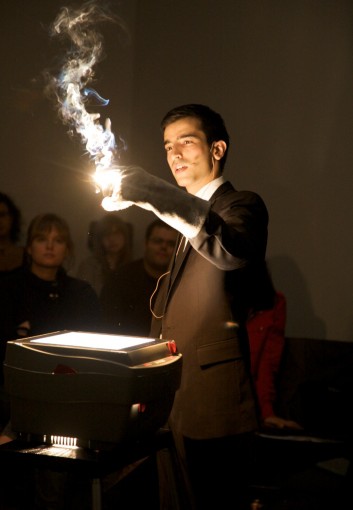
The Alkahest. 2009 Performance with overhead projector and transparencies. White Columns. New York.
In the Alkahest, I told a series of interwoven stories each chapter of which takes between 45 minutes to an hour and a half. [The stories] take place within a universe in which geographical locations, times and epochs are all blended together. One character is an alchemist who creates the eponymous alkahest by accident, there's the French playwright Moliere, Yves Klein, and Kurt Schwitters. We come across the Museum of Modern Art except in this story it's called the Museum of the Government of Manhattan (MOGM). The Alkahest refers to a mythical substance which alchemists searched for [in the middle ages] from which you could derive any other matter. This idea of blending together or mutability is also treated in other projects like the The Mark of the Third Stripe, a biography of Adi Dassier, the Founder of the Adidas Shoe Company. It's told as a sort of Lovecraftian or Faustian tale in which Adi Dassier is tainted and corrupted by a dark force that inhabits the very center of the Earth but is not the Judeo-Christian Satan but some conflation of gravity and time itself. [The work] fused different traditions and fields of knowledge.
The Assembly Instructions were developed as a sort of formal drawing in which I'm exploring ideas that are whimsical but around which I didn't necessarily want to create a gigantic all-consuming cosmological project. So they treated subjects like Ikea stores which are something that I had to visit to a lot. [There is] a piece in which Ikea is supposed to have been an index of all world human knowledge, encoded into these seemingly random arrangements of objects in the showroom. [Another] piece [collages] images of the protagonists of Grey's Anatomy and from Sex in the City with Lord Bryon and Alexander Pushkin, [creating a comparison between 19th century romanticism and 21st century TV sitcom, romantic heroines].
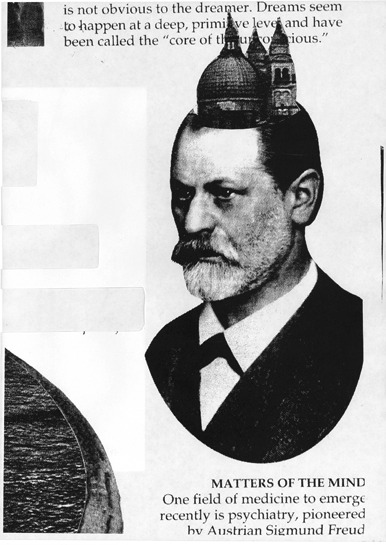
Assembly Instructions (Ikea), 2008
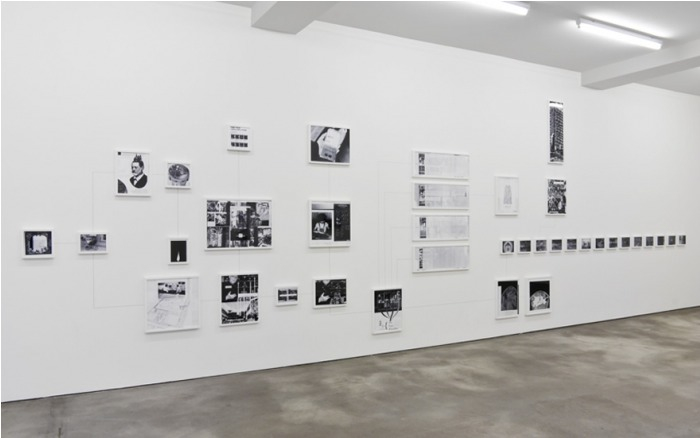
Assembly Instructions (Ikea), 2008

Assembly Instructions (Ikea), 2008
The show at the Drawing Center is a bit of reversal. In the past, I would have a little idea, and make a series of drawings that explore the idea. I see drawing as a way of thinking about something without getting too worried about the final form or explanation. There is something about drawing that allows for being more esoteric or cryptic, less obvious than a historical painting, for example. In the past I would create the collages and then a little bit later create the lectures where I essentially explain or, perhaps the right word would be, over-explain, the connections in the drawings.
For this project, I was invited to the Palais du Tokyo to create an issue for the PDT magazine on the subject of magic. Specifically I was given the word "The Pledge" which was extracted from the Christopher Priest novel, The Prestige. A magic act consists of three parts: the Pledge, in which the magician presents the audience with an ordinary object, the Turn, during which the magician transforms that object or makes it disappear and the Prestige, that moment of pleasant resolution in which the object is returned to its original state and the audience roars "Bravo!." I interpreted it very broadly in terms of first appearances, the beginning of things, the first word on the first page. Obviously as someone who is interested in pun and stories there were a lot of different ways to explore.
I conducted a series of seven interviews with individuals in different fields including the curator Marc-Olivier Wahler, filmmaker Michel Gondry, neurobiologist Leah Kelly, screenwriter Danny Rubin, artist Simon Fujiwara, theater directorAlfredo Arias, and critic Donatien Grau.
Each of the interviews were about finding a way in my own work and my world to express the essence of their ideas. I deliberately wanted to keep the conversation, the manner of interaction and the topics, seemingly light. I like the idea of being quite playful, I don't think that makes them particularly less profound; it's just a different kind of approach and so from those interviews I re-transcribed them just as you're about to do with this interview and, as you know, the editing of any interview is a highly creative act in which you completely arrange the words of the person with whom you are speaking. Some people take this very far and totally sanitize, hopefully, in a good way, the words of the person. I wanted to take this even a step further to place their ideas within stories or places [that could be completely fictional] so as to amplify those ideas. For example, my interview with the artist Simon Fujiwara takes place far in the future where an ancient decrepit Simon appears to observe the younger Simon and Alexandre Singh carrying on a discussion.
Those illustrations become the starting point for a series of further instructions or quasi-portraits into their ideas.
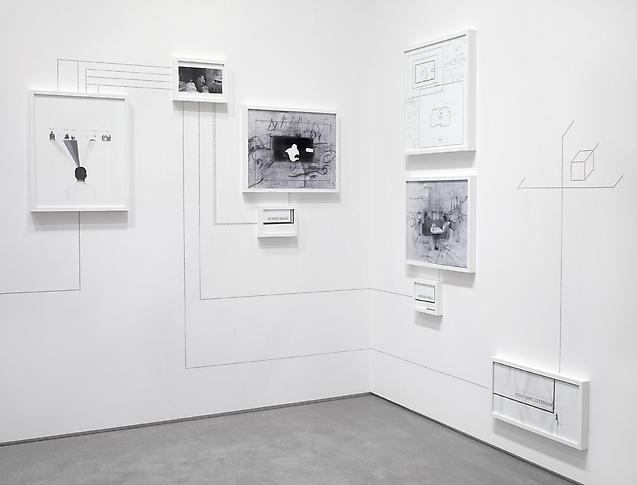
Assembly Instructions (The Pledge). 2013. Installation view. The Drawing Center, New York.
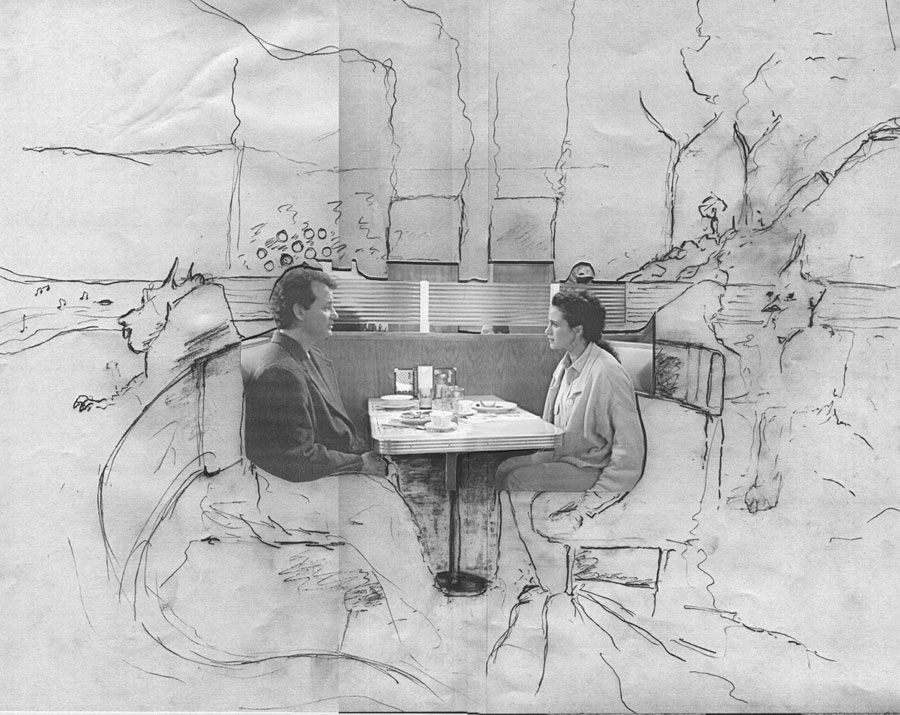
Assembly Instructions (The Pledge). 2013. Installation view. The Drawing Center, New York.
CEV: Reading those interviews, there is a certain free-form aspect of it but it does appear scripted. So there is that curation or perhaps recontextualization. How much of the interview as it's presented in its textual form, comports to what transpired in the spoken conversation.
AS: Probably 80% of the words they use, are the words they use. Sometimes I'd take whole passages where they are particularly coherent. Sometime there would be a paragraph constructed from five sentences taken from the beginning, middle and end of the conversation. Almost everything that I say, I didn't say - I'm giving you secrets here that a lot of people don't know, some people just assume that it's entirely made up, some people assume that I would never have the temerity to changes these people's words. The whole idea is to amplify their ideas via this mechanism of incorporating their stories into fantastical environments. I can place the film-maker Michel Gondry on a TGV train sitting right across from Pablo Picasso, to give another example, in order to provide richer context for his work.
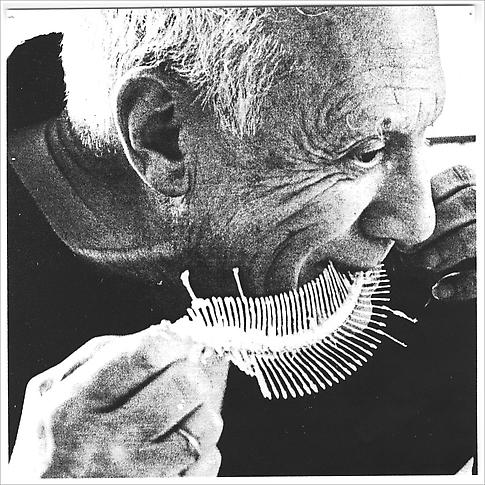
Assembly Instructions (The Pledge). 2013. Installation view. The Drawing Center, New York.
CEV: When you present that kind of textual information in a gallery setting like the Drawing Center and you provide a diagrammatic mapping to help the viewer, are you questioning the truth of the text or reinforcing it?
AS: I was taught at school to not accept any text as being true. In the beginning of history lessons there was the explanation that everyone has an agenda. So no matter if you find a book of the Encyclopedia Brittanica and you look the text, which was considered to be definitive, you realize that you can't trust anything in it. It amuses me when people complain about Wikipedia, "you know there are things in wikipedia that aren't true" but you can read any New York Times article and get a distorted view of the facts. The notion that I find very frustrating about print media is that it pretends to truthfulness.
If you treat your audience as intelligent and discerning they should realize that in terms of factual truths, the world is a vague and relative place. The whole joy of life is picking up and creating personal narratives out of these facts and that's what every individual layman does and every artist does as well.
CEV: What is your relationship with magic:
AS: I don't have a particular love of conjuring or illusion, which, for example, is something that was very important to Woody Allen. But I am very interested in belief or let's say imaginative belief related to magic. For example, something like Santa Claus, that's a kind of magical belief system. So are Abraham, Jesus and Moses, for that matter; these are things that you might think about as magic or one might call primitive rituals. This, in turn relates to performance and performativity. The kind of magic, that goes on when you attend a holy mass, or the same kind of magic that occurs in performance where things are being transformed into other things, unseen powers are operating. This kind of idea is a very rich tradition that goes all the way back to alchemy which is a precursor to the true science of chemistry.
But even there, chemistry itself is a type of magic. If you put sherbet in a coca-cola bottle and it explodes, there's something miraculous about that, a sort of transformation of substance. For me, all these things relate quite obviously to sculpture. Sculpture rests on two foundations. One is form, mass, weight and gravity - how an object touches the world, which is what I call the Charles Ray investigation of sculpture and the second is one material transforming into another material.
Marble turning into Mary and Jesus or Marcel Duchamps urinal transforming urine into gold. You can make a man out of marble, that is a simple kind of sculptural transformation.
CEV: When you consider our relationship to story-telling, we've come to expect a certain narrative arc, whether in oral story-telling, traditional structured forms like Homer or in conventional film-making, are you de-stabilizing that?
AS: There are structures that come out of a kind of oral tradition, Homer, as you say. But there are vestiges of that in Homeland or the Daily Show, too. In my performances, there is definitely an improvisational element to it in juggling the story while you fill in the details with a certain structure that is already pre-planned. I wouldn't go so far as to say that there is anything more profound in my manipulation of the audience's expectations during the lecture, though, in terms of disrupting a narrative arc towards some purpose. Audiences, in fact, are quite inured to what's going to happen, they've already got their guard up. They see everything with a sly wink. If I gave the lecture in a more traditional environment than perhaps it would be perceived differently.
CEV: In the story-telling that you've done, you utilize rather low-tech strategies to create a mood with the audience.
AS: I enjoy directness and simplicity. So, for example, I'm working on a play at the moment here in Rotterdam and when I present, I'm hoping to have no amplification of the actors, no recorded sound, definitely no video because what I find powerful and fascinating and fun is to create things in as direct and simple a manner as possible. I basically like Italian theater or Baroque theater when they make the sound of thunder by rolling the drum or they create a stormy sea by having two bits of cardboard moving in a parallax motion. There's something inventive, creative and charming about working that way.
Another criteria, which is an important criteria when you're working, is to create walls or a frame around process. If you say to yourself "I'm going to make a drawing on a piece of paper that is 6 inches by 6 inches using one type of felt marker" there's already a great limitation as to what you can do and that limitation focuses the mind and helps you be creative. If, on the other hand, you can do anything with everything in any genre anytime, it's hard to know where to begin. So one of the nice things about doing these performances with such simple tools is that I'm forced to be creative within those small parameters and those parameters themselves suggest interesting things that you could do. And besides, if I start doing shows with smoke machines and lasers, video projections and satellite linkups, you've already raised the bar of expectation with the audience. Once you've shown them the laser, they kind of expecting something even more interesting for the finale and that's quite problematic especially if the performances or experiments you're doing are for fun and not some huge stage show at the Barclay Center.
CEV: When you consider the most famous examples in the oral tradition, Homer, Arabian Nights, the Decameron. The duration of those stories were dictated by the circumstance in which they evolved. What's your perspective on duration? Some of the performances have been long, do you have a vision of what the right duration is and what impact does that have on the audience?
AS: I'm a bit of a hypocrite, because I want them to be as short as possible. To be honest, the performances of the Alkahest and that series I did at White Columns were a bit of a throwdown, it was kind of showing off to see if I could sustain a rich verbal dialogue for that amount of time. Because often, durational performances in fine art tend to be quite slow and not much happens for very long. So I was interested in "could I do a sort of Lord of the Rings where it's incredibly long and lots of things happen"
Duration was very much related to the medium, for example, if you're writing a radio play, it's very hard to get information across quickly because (a) you can't show anything and (b) if actors speak too quickly, it's much harder to follow than if they're speaking quickly on television or right in front of you; the brain can interpret language much more quickly if they see your lips and expression. So to create a very short radio play where something happens is very difficult. Feature films are good mediums that tell a lot of story very quickly. Each medium, in a sense, has a certain optimal length suggested by its restriction. In the performative visual arts, it's really hard to say because it's like creating its own genre one would hope. Each one is so very different. So in a sense I don't really have a good feel for things being short or long, it all relates to what kind of genre structure it's being written inside of.
CEV: Could you talk about your current project.
AS: I'm in Rotterdam now working on a project entitled "The Humans" that will open on September 28th here and then debut at the Brooklyn Academy of Music on November 13th. It's a retelling of the creation of the universe, a comic mythological story about a small world that is our world divided into two spheres: the Dionysian, ruled over by a tiny little character called the Nesquik Chocolate bunny and the Apollonian, ruled by a very fastidious spirit called Charles Ray. The story is about how the world is created in a sense by accident or inadvertently despite efforts by the protagonists to stop it. It's a comic take on life and existence itself.
CEV: I'm looking forward to seeing that. Thank you.
AS: Thank you.
